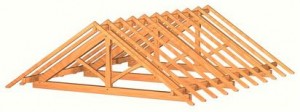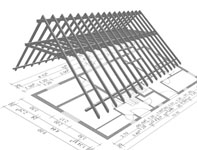How do steel trusses compare against wood trusses? Why do some builders use steel trusses, while others use wood trusses? In the construction of a building a precision job is required. This involves having proper safety considerations, adhering to building codes and other necessary procedures. For commercial buildings, steel trusses are a good option because they combine functionality with safety. Wood Trusses are often used in residential construction because it is expensive and requires less labour to assemble or install.
Both have advantages and disadvantages, depending on what the builder needs and the homeowner's preferences. When deciding whether to use steel trusses vs wood trusses it is important to understand how each type of truss works. Working with a building engineer can ensure that the right choice is made for the look you want.
Wood/Timber Roof Trusses
The Benefits of Wood Trusses
When considering steel trusses vs wood trusses, wooden trusses are generally less expensive. Timber also is more fire resistant than unprotected steel beams, because wood doesn't ignite until it reaches over 250 degrees. After it catches fire, it develops a protective coating. Contrastingly, steel weakens at temperatures over 230 degrees and loses most of its strength at over 750 degrees, and most house fires burn from 700 degrees to 1000 degrees. Large wood trusses are less likely to burn because the interior of the timber remains cooler than the unprotected steel.
The Disadvantages of Wood Trusses

There are disadvantages to wood trusses to consider as well when considering steel trusses vs. wood trusses. Wood can warp and bow, causing the roof to become damaged or even collapse over time. In addition, wood can rot or become infested with bugs if not maintained and treated properly. Timber is also more likely to become damaged by adverse weather conditions or lifting in high winds. However, because timber tends to be more cost effective than metal, it is still a popular roof truss materials choice.
Steel Roof Trusses
The Benefits of Steel Trusses
While steel trusses are more expensive than wooden trusses, they can span further than timber and can be manufactured to exact standards. They are also more lightweight, allowing larger shipments and reducing the time it takes to get to the project. This material is also fire resistant and compatible with nearly any type of roofing system. There is no risk of an insect infestation and no chemical treatments are necessary to maintain the trusses. Steel can also be easily recycled, making it environmentally friendly.
The Disadvantages of Steel Trusses

When considering steel trusses vs wood trusses, steel trusses require more skilled labor. They also allow more heat to escape from the home and are not as energy efficient. Sound is more easily transmitted with steel trusses. It also moves more with temperature fluctuations. In addition, the steel can rust where it is cut, drilled, welded or scratched. There is also a risk of electrocution when working with steel trusses. The wires in the steel can rub over time creating a hazard to anyone who touches the steel truss.
Picking the right type of truss depends on the style of the roof and the conditions inherent to the location. In a humid climate, wooden trusses may be the right choice, while in a commercial location steel trusses may provide more support. An experienced professional can help determine which building material is the right choice for a home or business.
